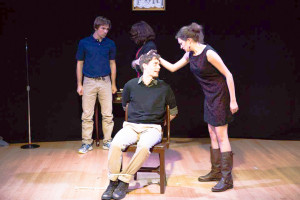How can college-age students tackle a tragedy about an elderly King descending into madness? The Stanford Shakespeare Company’s (StanShakes) production, directed by Kevin Heller ‘16, does so by bending the script to accommodate its younger cast and audience. Heller chooses to make the Lear family ordinary people, not royalty, whose matriarch struggles with early-onset Alzheimer’s Disease. While some of the Shakespearean text is lost in the adaptation, the production succeeds in its choice to cast a female lead to drive its story.

A few strong directorial choices were notable in guiding the production. Heller’s use of the outside porch, showing the audience scenes through the windows, was a clever use of the space. It was welcome — and refreshing — to see Heller cast Nora Tjossem ‘15 as the titular character, and in general be receptive to gender-bending male roles. More productions on campus would do well to follow in this vein.
Indeed, Tjossem’s Lear is not like any others you will see. Because her “madness” comes from Alzheimer’s, not senility or a fatal flaw, she’s more vulnerable and confused than other Lears. In one beautiful moment, she pleads, “O, let me not be mad, not mad, sweet heaven,” alone outside, as we watch her. Tjossem hints at age with her physicality, becoming at once elderly and childlike as she totters around in the storm. Her shuffling gait, confused blinking and wavering voice showed us the physical manifestations of losing touch with reality.
Still, the production refused to let Lear actually be old; though other characters, such as Kent and Gloucester had gray hair, she did not. This resulted in conflicts with the text at points — references to Lear being old and having white hair stand out. It wasn’t necessary, because Tjossem clearly could pull off the physicality of an older character.

Our first introduction to Lear and her family comes in her home, in that famous scene in which we are introduced to the family, and Lear asks each daughter to declare her love. Kaya McRuer ‘17 is strong as Cordelia, her earnestness shining as a sharp contrast to her sisters, particularly a harsh Goneril (Ellie Oates ‘14). Hanna Tyson ‘17 does really nice work as a Regan who is constantly attempting to convince herself she’s doing the right thing. When she lashes out later in violent moments, like removing Gloucester’s second eye, they almost seem to come from nowhere.
In this scene, furniture was effectively placed and used to create the feel of a home. However, it didn’t return often — a shame, because this type of staging would have worked well in other parts of the play, giving the actors physical objects to interact with and more movement options to visually tell the story more clearly.
One of the stronger visual elements of the production ended up being the costume design. Elliot Bomboy ‘17 created modern but specific looks for each character that melded well with their personalities — a fashion-conscious Regan contrasted with a simpler Cordelia.
The few comic moments were appreciated, adding energy to the production. An altercation between Adi Chang’s ‘18 loyal Kent and Matthew Libby’s ‘17 odiously servile Oswald resulted in the shorter Kent swinging towards the much taller Oswald, who sprinted away while screaming “Murder, murder!” at the top of his lungs. This type of exciting staging could’ve been extended to other parts of the production and other characters, such as Lear’s Fool, who has many songs and witty lines that didn’t reach their full impact.
Some technical points could have given the production more clarity. While cutting the script was necessary, key plot points were also excised. In this “Lear,” Goneril and Regan no longer have affairs with Edmund, so we don’t really understand why and how Goneril poisoned Regan at the end. In fact, these cuts lead Edmund’s subplot — plotting against his father Gloucester and brother Edgar — to seem somewhat disconnected from the Lear family’s story. More text work would have served the play well; some beautiful monologues, such as the famous “Thou, Nature, art my goddess” in I.II, felt rushed and ends of phrases were swallowed. The sounds during the storm, admirably designed by Sam Reamer ‘18, were evocative but drowned out the actors at points. Increased vocal projection would’ve helped us catch lines of dialogue that couldn’t be heard, at this moment and others.
StanShakes did an admirable job bringing this behemoth of a play to its feet. While some moments could have been clearer or more energetic, “Lear” succeeded in featuring strong female actors and its willingness to stray from the traditional proscenium stage.
Contact Noemi Berkowitz at noemi11 “at” stanford.edu.
